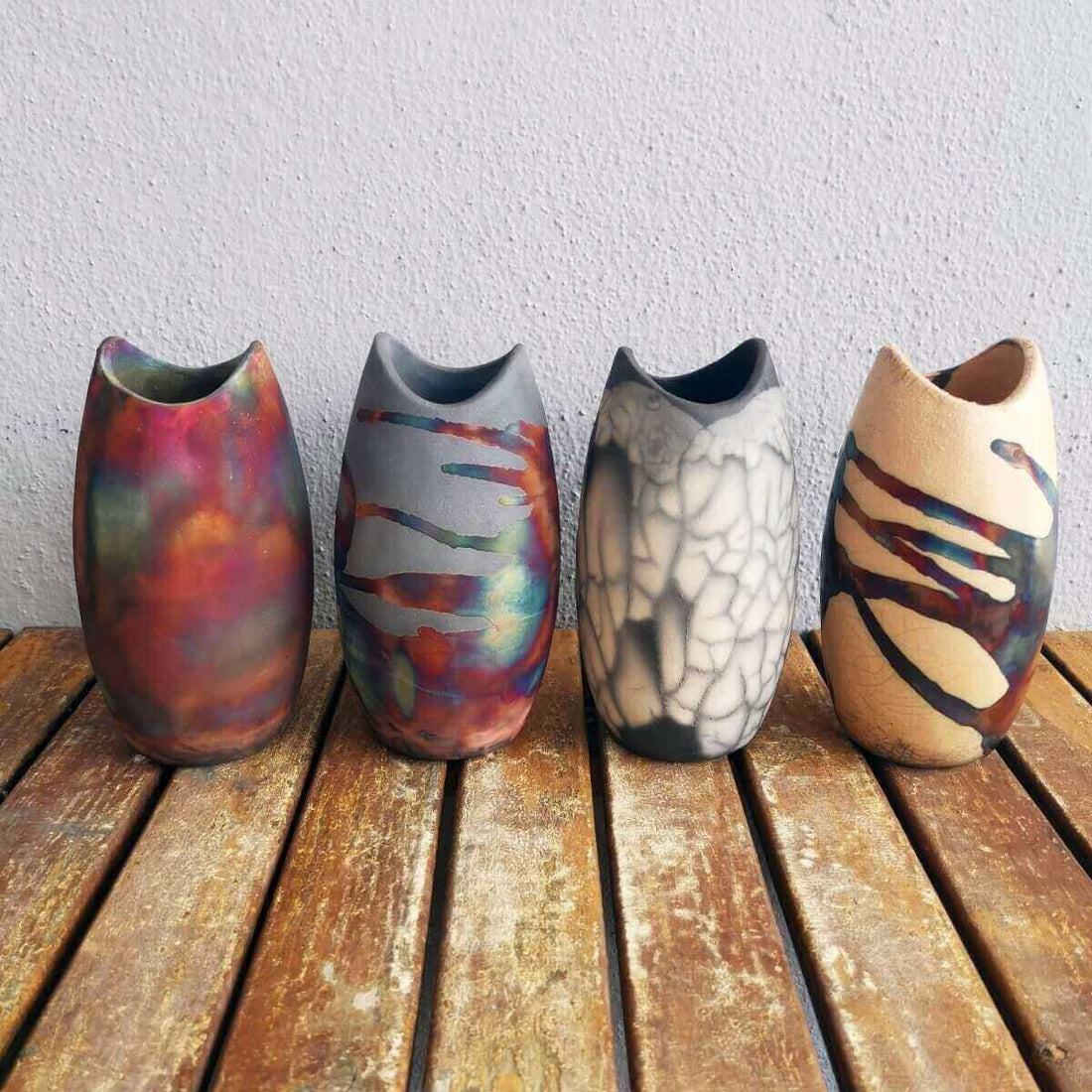
The history of Raku fired pottery and the raku copper matte technique
Raku ceramic pottery is a traditional Japanese style of pottery that dates back to the 16th century. It was originally developed by Chojiro, a student of the tea master Sen no Rikyu, as a way to create tea bowls for the Japanese tea ceremony. The word "raku" means "enjoyment" or "ease," reflecting the relaxed and informal atmosphere of the tea ceremony. Raku ceramics are known for their distinctive, rough texture, and often feature crackled or iridescent glazes. The pottery is fired at a low temperature and then removed from the kiln while still red-hot and placed in a container with combustible materials, which creates unique, one-of-a-kind patterns and textures on the surface of the piece. Today, raku pottery is enjoyed not just in Japan, but around the world as a form of folk art and expression.
Here is a quick guide on the 6 raku pottery vase finishes
The Raku copper matte process is a firing technique used in Raku pottery. It's a unique and complex method that creates distinctive and beautiful finishes on Raku ceramic pieces.

Here's an overview of the process:
Preparation: The Raku pottery is made using a low-fire clay body and glazed with a special Raku glaze. The glaze contains copper, which reacts with the carbon in the smoke during the firing process to create the distinctive matte finish.

Firing: The Raku pottery is fired to a temperature between 1,700-1,800°F. This temperature is high enough to make the glaze and clay vitreous and durable, but not so high as to cause it to become fully vitrified.
If you would like to see my most popular raku piece? Check it out here.

Cooling: After firing, the Raku pottery is removed from the kiln while still red hot, and placed in a reduction chamber. This reduction chamber can be anything from a metal trash can to a pit dug in the ground, and is filled with combustible materials such as sawdust or paper. The pottery is covered and the reduction chamber is set on fire, creating smoke that suffocates the oxygen in the chamber. This lack of oxygen creates the distinctive matte finish.

Finishing: After the reduction process, the Raku pottery is removed from the reduction chamber and cooled rapidly. This cooling process can cause the glaze to crack, which is often desirable in Raku pottery. The finished piece is then cleaned, revealing the unique matte finish created by the reduction process.

It's important to note that Raku pottery is not considered food safe, as the rapid cooling and reduction process can cause the glaze to be porous and potentially allow bacteria to grow. It's best used as decorative pieces only.
Although Raku pottery is very beautiful there are risks associated with Raku copper matte firing.
Raku firing involves reaching very high temperatures and using glazes that can produce toxic fumes. Inhaling the fumes can cause respiratory problems. One must always use propose safety gear such as respirators, face shields and ceramic gloves to prevent accidents.
Raku firing can produce open flames and sparks, which can be a fire risk if proper safety precautions are not taken. It is important to have fire extinguishers nearby and to conduct fire safety training for all team members involved in raku firing.
Raku pottery is typically removed from the kiln while it is still hot and placed in a container with combustible materials, which can cause it to crack or break. When the piece breaks, it can produce very sharp shards or even explode. Great care must be taken during these times.
The Raku firing process is highly dependent on temperature and timing, and the results can be inconsistent from piece to piece. This is one of the joys of raku firing. Every piece is unique and has the potential to become a masterpiece.
It is important to follow safety guidelines and to use proper protective gear when performing Raku firing to minimize these risks. I wish you all the best in your raku firing journey!
Read more about the advantages and disadvantages of using ceramic planter pots here.

1 comment
I love your site, I have a raku vase/bowl